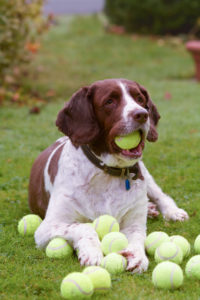
This month’s spotlight is on the training approach of SMART x50 which is from the book “Plenty in Life Is Free” by Kathy Sdao. This concept is a key component of my own training approach, and is one that I discuss with nearly all my clients. Read on for more about this helpful guiding principle as you develop a relationship with your puppy or dog…
“Plenty In Life Is Free” is part personal memoir, part philosophy, and part training book. The author is a woman I admire very much as a professional colleague and as a human being. It’s written in a simple, approachable, personable, and authentic style. She gets into a lot of personal detail (including her personal religious beliefs) in a way that blurs the usual boundaries between personal and professional, which is why I would say it’s not strictly speaking a training how-to book, but she does this in order to describe her own journey and without implying that anyone else should or would share the same journey.
In terms of training, she describes her quest to find a concise and effective way to coach her dog training clients in ways that are actually consistent with the way she relates with her own dogs, and consistent with her own ethics and beliefs. This meant leaving behind traditional dog training instructions which often included “Nothing In Life Is Free (NILF)” i.e. having your dog perform a simple task before receiving anything at all that they wanted such as going outside, food, affection, etc. This approach was meant to teach the dog that pleasant consequences would follow if they did the things we asked, which is a useful concept in order to take advantage of one way in which dogs learn. Unfortunately, this approach, while not wrong or bad per se, comes from a place of withholding and control, or even micromanagement; it is easy to take it too far, and it doesn’t reflect the reality of the relationship we want to have with our dogs. We want to enjoy their company, not have to constantly tell them what to do. Why is it that we as trainers were telling clients to do this but not doing it with our own dogs? And clients were coming back and saying, “I know I’m supposed to make them sit before doing [X behavior], but…” So Kathy came up with a different way to approach this: SMART x50, an acronym for See Mark and Reward Training.
Quite simply, the idea is that we should be looking for as many opportunities as possible (at least 50 per day to start) to reward our dogs. What are they already getting right? How can we be more generous?

Be generous with what your dog likes!
It means we need to learn to notice (See) our dogs doing behaviors we think are “good,” acknowledge (Mark) those behaviors, and Reward them. In so doing, we grow and build the behaviors we would like to see more of (assuming our rewards are timely, and meaningful to the dog in that context), and we give ourselves the chance to get really practiced and skilled at seeing the good in our dogs. As humans, it’s natural for us to notice when things go wrong, rather than when things go right. It takes practice to change that. This approach still teaches dogs that pleasant consequences follow from various behaviors we like, but it comes from the perspective of abundance and choice and love, rather than expecting that we need to always instruct every behavior and parcel out rewards in a miserly fashion. We shouldn’t hesitate to give affection and fun and treats, including “for free;” this is enjoyable and important for us and for our dogs. The difference is not just semantics, it’s a meaningful shift that is more conducive to building a relationship that consists of more than us barking commands and our dogs obeying. I talk about this concept and its practical application with nearly all of my training clients. I will always be grateful to Kathy for articulating this approach so clearly in her book, which I really enjoyed reading and recommend often to others.
It helps to visualize and get clarity for yourself in advance on that exactly “being good” looks like, so that you are primed to notice it when it’s happening, and reward it. Sometimes it’s something the dog does on their own, and sometimes it’s their response to a cue we’ve given them. Rewards can be food treats, play, walks, affection, praise, etc. — whatever your dog will really enjoy in that moment and in that context. Try this tomorrow with your dog. What are the behaviors you want to grow? What does your dog find rewarding? (Hint: it’s not always the same thing in every moment or context)

an example of a puppy being “good” by chewing on an appropriate toy
